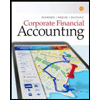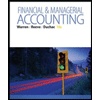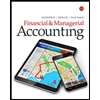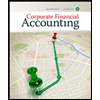
Exercise 16-16BDirect: Computing
For each of the following separate cases, compute the required cash flow information.
Case X: Compute cash received from customers
Sales................................ $515,000
Accounts receivable. Ending balance..... 33,500
Case Y: Compute cash paid for rent
Rent expense......................... $139.3.00
Rent payable. Beginning balance......... 7.S00
Rent payable. Ending balance........... £.200
Case Z: Compute cash paid for inventory
Cost of goods sold.................. $525,000
Inventory, Beginning balance......... 15B.&00
Accounts payable, Beginning balance ... 56,700
Inventory, Ending balance............ 130,400
Accounts payable, Ending balance..... 32,000
Want to see the full answer?
Check out a sample textbook solution
Chapter 16 Solutions
FUND.ACCT.PRIN.-CONNECT ACCESS
- Please fill the empty cell in this problem. It is the only thing I need.arrow_forwardPlease explain the solution to this financial accounting problem with accurate principles.arrow_forwardWhat exactly are intangible assets and how are they defined? How are intangible assets different from plant assets?arrow_forward
- Answer this without using chatgtp or AIarrow_forwardNicole is a calendar-year taxpayer who accounts for her business using the cash method. On average, Nicole sends out bills for about $12,000 of her services on the first of each month. The bills are due by the end of the month, and typically 70 percent of the bills are paid on time and 98 percent are paid within 60 days. a. Suppose that Nicole is expecting a 2 percent reduction in her marginal tax rate next year. Ignoring the time value of money, estimate the tax savings for Nicole if she postpones mailing the December bills until January 1 of next year.arrow_forwardGeneral accountingarrow_forward
 Accounting (Text Only)AccountingISBN:9781285743615Author:Carl Warren, James M. Reeve, Jonathan DuchacPublisher:Cengage Learning
Accounting (Text Only)AccountingISBN:9781285743615Author:Carl Warren, James M. Reeve, Jonathan DuchacPublisher:Cengage Learning Corporate Financial AccountingAccountingISBN:9781305653535Author:Carl Warren, James M. Reeve, Jonathan DuchacPublisher:Cengage Learning
Corporate Financial AccountingAccountingISBN:9781305653535Author:Carl Warren, James M. Reeve, Jonathan DuchacPublisher:Cengage Learning Financial & Managerial AccountingAccountingISBN:9781285866307Author:Carl Warren, James M. Reeve, Jonathan DuchacPublisher:Cengage Learning
Financial & Managerial AccountingAccountingISBN:9781285866307Author:Carl Warren, James M. Reeve, Jonathan DuchacPublisher:Cengage Learning Financial & Managerial AccountingAccountingISBN:9781337119207Author:Carl Warren, James M. Reeve, Jonathan DuchacPublisher:Cengage Learning
Financial & Managerial AccountingAccountingISBN:9781337119207Author:Carl Warren, James M. Reeve, Jonathan DuchacPublisher:Cengage Learning Corporate Financial AccountingAccountingISBN:9781337398169Author:Carl Warren, Jeff JonesPublisher:Cengage Learning
Corporate Financial AccountingAccountingISBN:9781337398169Author:Carl Warren, Jeff JonesPublisher:Cengage Learning





